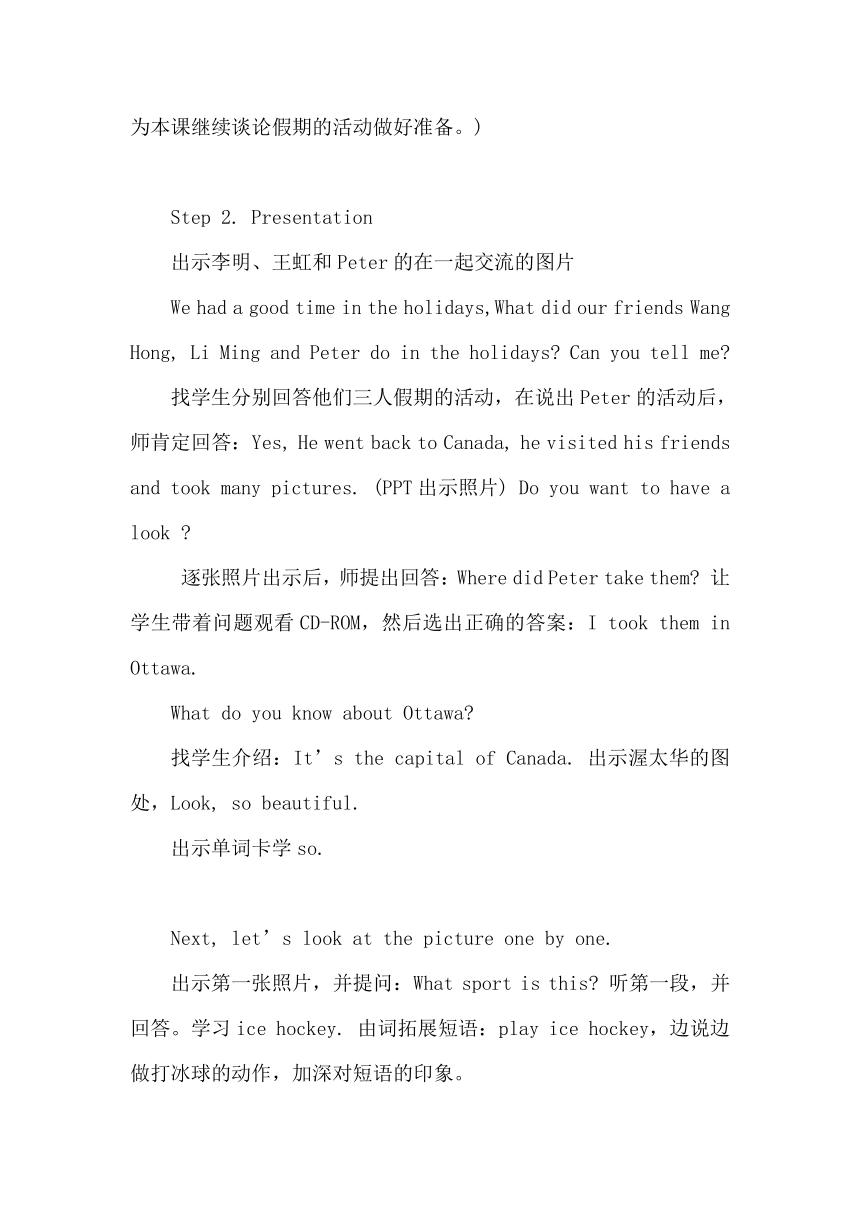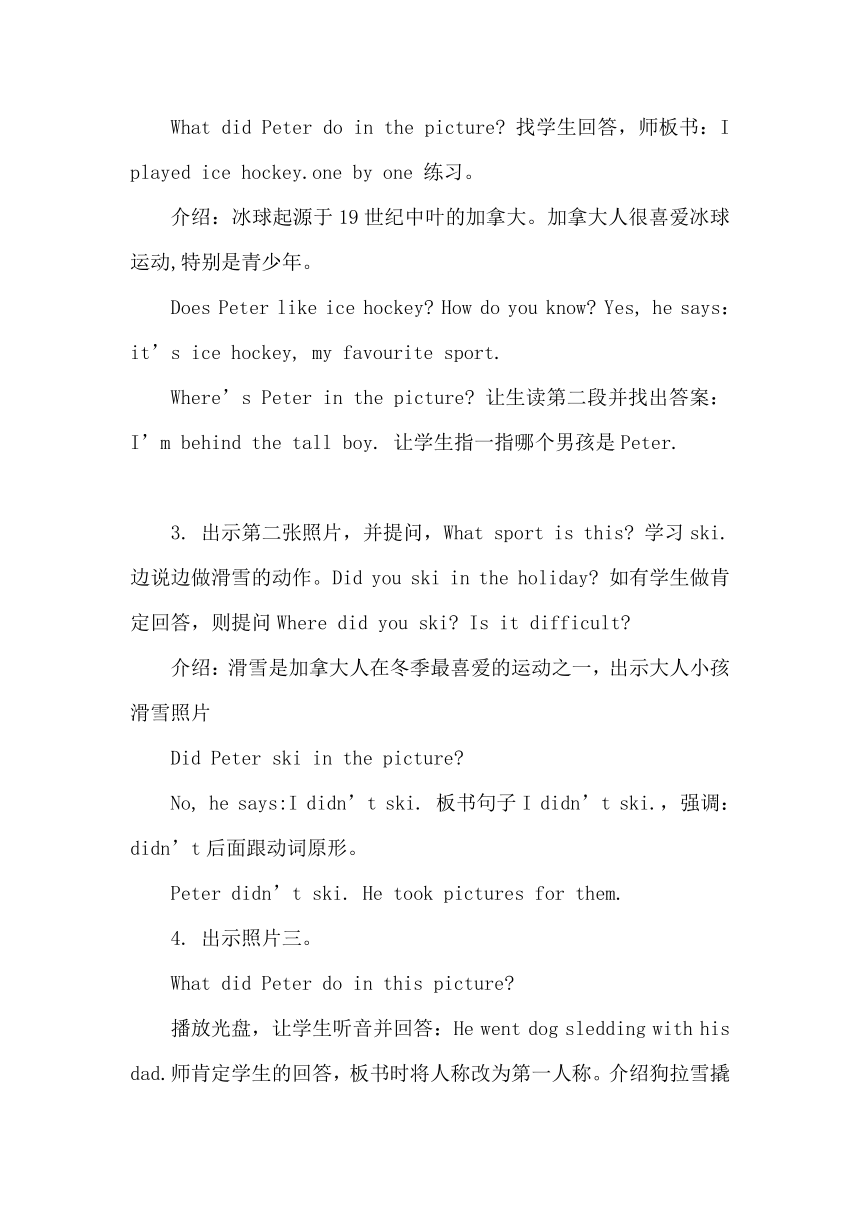英语五年级下鲁科版 Unit 1 Winter holidays lesson 2 I didn’t ski.教案
文档属性
| 名称 | 英语五年级下鲁科版 Unit 1 Winter holidays lesson 2 I didn’t ski.教案 |  | |
| 格式 | zip | ||
| 文件大小 | 15.5KB | ||
| 资源类型 | 教案 | ||
| 版本资源 | 鲁科版(五四制) | ||
| 科目 | 英语 | ||
| 更新时间 | 2014-11-17 16:56:20 | ||
图片预览



文档简介
Unit 1 Winter holidays
lesson 2: I didn’t ski.
一、教学目标:
1.知识目标:能听懂、会说并认读句型: I didn't ski. I went dog sledding with my dad. I went ice fishing on the lake.
2. 能力目标:能听懂、会说并认读单词so, ice hockey, ski, dog sledding, also, ice fishing, lake, got能四会掌握单词dog , lake. 能用一般过去时的肯定和否定形式谈论过去所做的事情.
3.情感目标:培养学生喜欢运动的习惯。
二、教学重难点
1.教学重点:能用一般过去时的肯定和否定形式谈论过去所做的事情。
2.教学难点:一般过去时的肯定和否定形式中动词用法的区别。
三 教学方法:情境教学法
四 教具:卡片,PPT课件
五、教学过程
Step 1. Warm up
Free talk
T:What did you do in the holidays?
在学生做出回答后,师适当展开提问,如:Did you enjoy your holidays? Did you take pictures there?
(设计意图:在与学生交流的过程中复习了第一节课所学句型,为本课继续谈论假期的活动做好准备。)
Step 2. Presentation
出示李明、王虹和Peter的在一起交流的图片
We had a good time in the holidays,What did our friends Wang Hong, Li Ming and Peter do in the holidays? Can you tell me?
找学生分别回答他们三人假期的活动,在说出Peter的活动后,师肯定回答:Yes, He went back to Canada, he visited his friends and took many pictures. (PPT出示照片) Do you want to have a look ?
逐张照片出示后,师提出回答:Where did Peter take them? 让学生带着问题观看CD-ROM,然后选出正确的答案:I took them in Ottawa.
What do you know about Ottawa?
找学生介绍:It’s the capital of Canada. 出示渥太华的图处,Look, so beautiful.
出示单词卡学so.
Next, let’s look at the picture one by one.
出示第一张照片,并提问:What sport is this? 听第一段,并回答。学习ice hockey. 由词拓展短语:play ice hockey,边说边做打冰球的动作,加深对短语的印象。
What did Peter do in the picture? 找学生回答,师板书:I played ice hockey.one by one 练习。
介绍:冰球起源于19世纪中叶的加拿大。加拿大人很喜爱冰球运动,特别是青少年。
Does Peter like ice hockey? How do you know? Yes, he says:it’s ice hockey, my favourite sport.
Where’s Peter in the picture? 让生读第二段并找出答案:I’m behind the tall boy. 让学生指一指哪个男孩是Peter.
3. 出示第二张照片,并提问,What sport is this? 学习ski. 边说边做滑雪的动作。Did you ski in the holiday? 如有学生做肯定回答,则提问Where did you ski? Is it difficult?
介绍:滑雪是加拿大人在冬季最喜爱的运动之一,出示大人小孩滑雪照片
Did Peter ski in the picture?
No, he says:I didn’t ski. 板书句子I didn’t ski.,强调:didn’t后面跟动词原形。
Peter didn’t ski. He took pictures for them.
4. 出示照片三。
What did Peter do in this picture?
播放光盘,让学生听音并回答:He went dog sledding with his dad.师肯定学生的回答,板书时将人称改为第一人称。介绍狗拉雪撬运动:一部雪橇上两人。通常四只或六只雪橇犬在雪橇前面拉,一人坐在铺鹿皮的椅子上,另一人站在后面雪橇的滑行板上。
It’s cool.
5.出示照片四
Peter was very happy in the picture, why? 播放光盘,找生回答:He got a big fish. He also went ice fishing on the lake. 板书,出示单词卡学习ice fishing, also之后领读句型。 介绍:ice fishing
指着Danny手中的鱼说:Look, Danny got a fish too. But it’s different from Peter’s fish. It means:年年有余
(逐张出示照片,让学生通过观察照片、观看光盘,听一听、读一读并找出问题的答案等方式,学习了重点句型和单词,最终理解课文内容,学生在兴致勃勃地看照片的过程中学习课文。通过对这些活动的介绍,学生也开阔了眼界,同时加深了对异国文化的了解)
6. 跟读课文
7.分角色读课文
Step 3. Practise.
Read and choose.
Peter took the pictures in _________. A. London B. Ottawa
Peter’s favourtie sport is ______________. A. ice hockey B. ski
Peter didn’t _____. A. ski B. skied
Peter went __________ with his dad. A. dog sledding B. swimming
Peter also went___________on the lake. A.ice fishing B. dog sledding
Danny didn’t _____ ice fishing., but he got a fish too. A. go B. went
chant
ice hockey, ice hockey, I played ice hockey.
Dog sledding, dog sledding, I went dog sledding.
Ice fishing, ice fishing, I went
Ski, ski, I didn’t ski.
Skate, skate, I didn’t skate.
Swim, swim, I didn’t swim.
Let’s talk.
出示六幅图片,让生先集体读出短语。(复习短语,为接下来谈论假期活动做好准备。)
(其中前三幅,师有意识的选择三幅结构相同的短语:go swimming, go ice fishing, go dog sledding. 并让学生在读完之后来总结,加深对短语的印象。)
读完短语,师先示范,分别谈论假期中做过和没做的事情。之后,do pair work让同伴俩进行交流,之后展示。
Step 4. Let’s do.
调查小组内成员假期中所做事情,使用书中表格,也可以增加或补充表格内容,例:get lucky money, visit relatives.
师先示范,调查一位同学,并向大家进行汇报。之后小组活动并汇报展示。
Step 5. Summary and Homework.
小结:齐读板书重点句型和单词,强调didn’t后面跟动词原形。
作业:listen to the tape and read the dialogue.
板书:
L2 I didn’t ski.
I went dog sledding
ice fishing.
Played ice hockey
教后反思:
本课主要是使学生学会表达在过去时间内未做的事情,重点句型是: Did you …? Yes, I did. / No, I didn’t. I didn’t ski 由于涉及到动词过去式的变化规则和读音规则,一般过去式又是学生的学习难点之一。建议教师在此基础上创设真实情境、组织有意义的任务或活动来展开一般过去式的教学,避免过分强调语法。本单元的内容安排体现了由浅入深、循序渐进的原则,A部分着重学习规则动词的过去式变化,而B部分的重点是不规则动词的过去式变化,如:go ---- went, read ---- read等。在教学中,要注意多创设情境,帮助学生内化,并达到学以致用。本单元的学习内容为过去式的运用,对学生来说,感觉还是有一定的难度的,训练时,还应多加练习。
lesson 2: I didn’t ski.
一、教学目标:
1.知识目标:能听懂、会说并认读句型: I didn't ski. I went dog sledding with my dad. I went ice fishing on the lake.
2. 能力目标:能听懂、会说并认读单词so, ice hockey, ski, dog sledding, also, ice fishing, lake, got能四会掌握单词dog , lake. 能用一般过去时的肯定和否定形式谈论过去所做的事情.
3.情感目标:培养学生喜欢运动的习惯。
二、教学重难点
1.教学重点:能用一般过去时的肯定和否定形式谈论过去所做的事情。
2.教学难点:一般过去时的肯定和否定形式中动词用法的区别。
三 教学方法:情境教学法
四 教具:卡片,PPT课件
五、教学过程
Step 1. Warm up
Free talk
T:What did you do in the holidays?
在学生做出回答后,师适当展开提问,如:Did you enjoy your holidays? Did you take pictures there?
(设计意图:在与学生交流的过程中复习了第一节课所学句型,为本课继续谈论假期的活动做好准备。)
Step 2. Presentation
出示李明、王虹和Peter的在一起交流的图片
We had a good time in the holidays,What did our friends Wang Hong, Li Ming and Peter do in the holidays? Can you tell me?
找学生分别回答他们三人假期的活动,在说出Peter的活动后,师肯定回答:Yes, He went back to Canada, he visited his friends and took many pictures. (PPT出示照片) Do you want to have a look ?
逐张照片出示后,师提出回答:Where did Peter take them? 让学生带着问题观看CD-ROM,然后选出正确的答案:I took them in Ottawa.
What do you know about Ottawa?
找学生介绍:It’s the capital of Canada. 出示渥太华的图处,Look, so beautiful.
出示单词卡学so.
Next, let’s look at the picture one by one.
出示第一张照片,并提问:What sport is this? 听第一段,并回答。学习ice hockey. 由词拓展短语:play ice hockey,边说边做打冰球的动作,加深对短语的印象。
What did Peter do in the picture? 找学生回答,师板书:I played ice hockey.one by one 练习。
介绍:冰球起源于19世纪中叶的加拿大。加拿大人很喜爱冰球运动,特别是青少年。
Does Peter like ice hockey? How do you know? Yes, he says:it’s ice hockey, my favourite sport.
Where’s Peter in the picture? 让生读第二段并找出答案:I’m behind the tall boy. 让学生指一指哪个男孩是Peter.
3. 出示第二张照片,并提问,What sport is this? 学习ski. 边说边做滑雪的动作。Did you ski in the holiday? 如有学生做肯定回答,则提问Where did you ski? Is it difficult?
介绍:滑雪是加拿大人在冬季最喜爱的运动之一,出示大人小孩滑雪照片
Did Peter ski in the picture?
No, he says:I didn’t ski. 板书句子I didn’t ski.,强调:didn’t后面跟动词原形。
Peter didn’t ski. He took pictures for them.
4. 出示照片三。
What did Peter do in this picture?
播放光盘,让学生听音并回答:He went dog sledding with his dad.师肯定学生的回答,板书时将人称改为第一人称。介绍狗拉雪撬运动:一部雪橇上两人。通常四只或六只雪橇犬在雪橇前面拉,一人坐在铺鹿皮的椅子上,另一人站在后面雪橇的滑行板上。
It’s cool.
5.出示照片四
Peter was very happy in the picture, why? 播放光盘,找生回答:He got a big fish. He also went ice fishing on the lake. 板书,出示单词卡学习ice fishing, also之后领读句型。 介绍:ice fishing
指着Danny手中的鱼说:Look, Danny got a fish too. But it’s different from Peter’s fish. It means:年年有余
(逐张出示照片,让学生通过观察照片、观看光盘,听一听、读一读并找出问题的答案等方式,学习了重点句型和单词,最终理解课文内容,学生在兴致勃勃地看照片的过程中学习课文。通过对这些活动的介绍,学生也开阔了眼界,同时加深了对异国文化的了解)
6. 跟读课文
7.分角色读课文
Step 3. Practise.
Read and choose.
Peter took the pictures in _________. A. London B. Ottawa
Peter’s favourtie sport is ______________. A. ice hockey B. ski
Peter didn’t _____. A. ski B. skied
Peter went __________ with his dad. A. dog sledding B. swimming
Peter also went___________on the lake. A.ice fishing B. dog sledding
Danny didn’t _____ ice fishing., but he got a fish too. A. go B. went
chant
ice hockey, ice hockey, I played ice hockey.
Dog sledding, dog sledding, I went dog sledding.
Ice fishing, ice fishing, I went
Ski, ski, I didn’t ski.
Skate, skate, I didn’t skate.
Swim, swim, I didn’t swim.
Let’s talk.
出示六幅图片,让生先集体读出短语。(复习短语,为接下来谈论假期活动做好准备。)
(其中前三幅,师有意识的选择三幅结构相同的短语:go swimming, go ice fishing, go dog sledding. 并让学生在读完之后来总结,加深对短语的印象。)
读完短语,师先示范,分别谈论假期中做过和没做的事情。之后,do pair work让同伴俩进行交流,之后展示。
Step 4. Let’s do.
调查小组内成员假期中所做事情,使用书中表格,也可以增加或补充表格内容,例:get lucky money, visit relatives.
师先示范,调查一位同学,并向大家进行汇报。之后小组活动并汇报展示。
Step 5. Summary and Homework.
小结:齐读板书重点句型和单词,强调didn’t后面跟动词原形。
作业:listen to the tape and read the dialogue.
板书:
L2 I didn’t ski.
I went dog sledding
ice fishing.
Played ice hockey
教后反思:
本课主要是使学生学会表达在过去时间内未做的事情,重点句型是: Did you …? Yes, I did. / No, I didn’t. I didn’t ski 由于涉及到动词过去式的变化规则和读音规则,一般过去式又是学生的学习难点之一。建议教师在此基础上创设真实情境、组织有意义的任务或活动来展开一般过去式的教学,避免过分强调语法。本单元的内容安排体现了由浅入深、循序渐进的原则,A部分着重学习规则动词的过去式变化,而B部分的重点是不规则动词的过去式变化,如:go ---- went, read ---- read等。在教学中,要注意多创设情境,帮助学生内化,并达到学以致用。本单元的学习内容为过去式的运用,对学生来说,感觉还是有一定的难度的,训练时,还应多加练习。
同课章节目录
- Unit 1 Winter Holidays
- Lesson 1 What did you do in the holidays?
- Lesson 2 I didn’t ski.
- Lesson 3 Everyone was happy that day.
- Lesson 4 Again ,please!
- Unit 2 Good Behaviou
- Lesson 1 Let’s stop and wait
- Lesson 2 Don’t shout,please.
- Lesson 3They are in the zoo.
- Lesson 4 Again ,please!
- Unit 3 Health
- Lesson 1 What’s wrong with you?
- Lesson 2 How are you feeling today?
- Lesson 3 How can we keep healthy?
- Lesson 4 Again ,please!
- Unit4 Neighbourhood
- Lesson 1 He lives next to me.
- Lesson 2 Is there a gym around?
- Lesson 3 They are having lots of fun.
- Lesson 4 Again ,please!
- Unit 5 Country Life
- Lesson 1 There is a river near the village.
- Lesson 2 How many ducks do you have?
- Lesson 3 He goes to school by school bus.
- Lesson 4 Again ,please!
- Unit 6 Plan for the Summe
- Lesson 1 What are you going to do this summer holi
- Lesson 2 You’d better take an umbrella.
- Lesson 3 Get ready for a new school life!
- Lesson 4 Again ,please!
